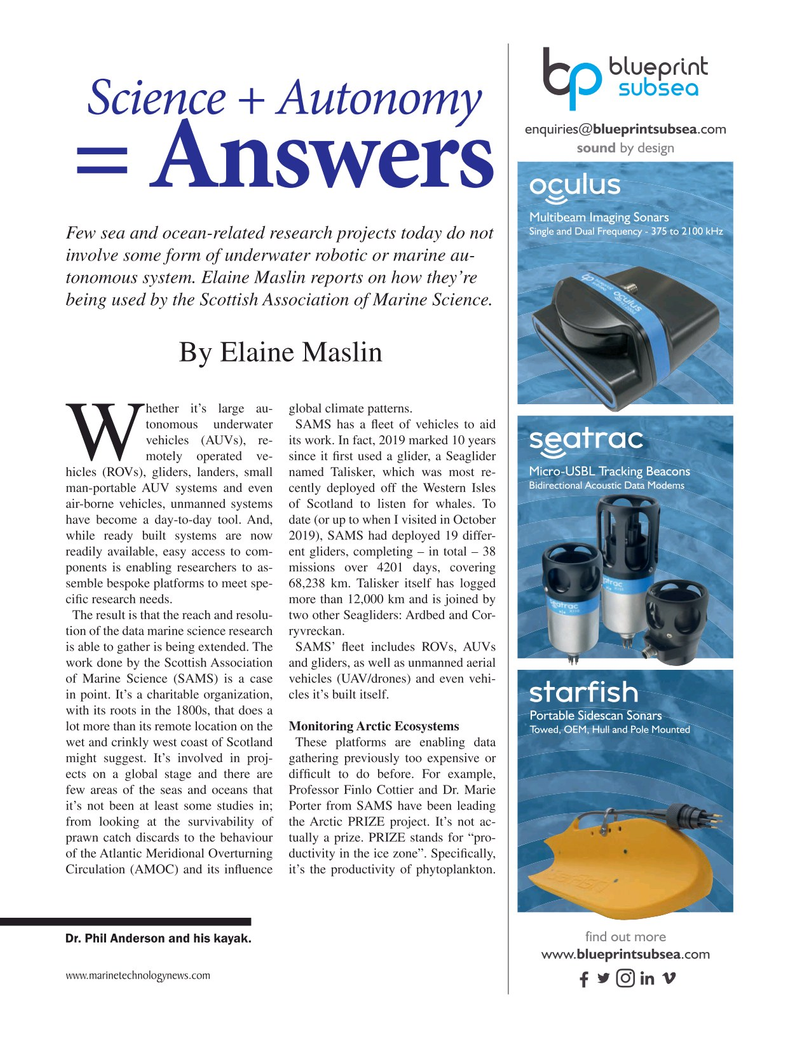
Page 21: of Marine Technology Magazine (January 2020)
Read this page in Pdf, Flash or Html5 edition of January 2020 Marine Technology Magazine
Science + Autonomy
HQTXLULHV#EOXHSULQWVXEVHDFRP
VRXQGE\GHVLJQ = Answers 0XOWLEHDP,PDJLQJ6RQDUV 6LQJOHDQG'XDO)UHTXHQF\WRN+]
Few sea and ocean-related research projects today do not involve some form of underwater robotic or marine au- tonomous system. Elaine Maslin reports on how they’re being used by the Scottish Association of Marine Science.
By Elaine Maslin hether it’s large au- global climate patterns. tonomous underwater SAMS has a ? eet of vehicles to aid vehicles (AUVs), re- its work. In fact, 2019 marked 10 years
Wmotely operated ve- since it ? rst used a glider, a Seaglider hicles (ROVs), gliders, landers, small named Talisker, which was most re- 0LFUR86%/7UDFNLQJ%HDFRQV %LGLUHFWLRQDO$FRXVWLF'DWD0RGHPV man-portable AUV systems and even cently deployed off the Western Isles air-borne vehicles, unmanned systems of Scotland to listen for whales. To have become a day-to-day tool. And, date (or up to when I visited in October while ready built systems are now 2019), SAMS had deployed 19 differ- readily available, easy access to com- ent gliders, completing – in total – 38 ponents is enabling researchers to as- missions over 4201 days, covering semble bespoke platforms to meet spe- 68,238 km. Talisker itself has logged ci? c research needs. more than 12,000 km and is joined by
The result is that the reach and resolu- two other Seagliders: Ardbed and Cor- tion of the data marine science research ryvreckan.
is able to gather is being extended. The SAMS’ ? eet includes ROVs, AUVs work done by the Scottish Association and gliders, as well as unmanned aerial of Marine Science (SAMS) is a case vehicles (UAV/drones) and even vehi- in point. It’s a charitable organization, cles it’s built itself. with its roots in the 1800s, that does a 3RUWDEOH6LGHVFDQ6RQDUV lot more than its remote location on the Monitoring Arctic Ecosystems 7RZHG2(0+XOODQG3ROH0RXQWHG wet and crinkly west coast of Scotland These platforms are enabling data might suggest. It’s involved in proj- gathering previously too expensive or ects on a global stage and there are dif? cult to do before. For example, few areas of the seas and oceans that Professor Finlo Cottier and Dr. Marie it’s not been at least some studies in; Porter from SAMS have been leading from looking at the survivability of the Arctic PRIZE project. It’s not ac- prawn catch discards to the behaviour tually a prize. PRIZE stands for “pro- of the Atlantic Meridional Overturning ductivity in the ice zone”. Speci? cally,
Circulation (AMOC) and its in? uence it’s the productivity of phytoplankton.
ILQGRXWPRUH
Dr. Phil Anderson and his kayak.
ZZZEOXHSULQWVXEVHDFRP www.marinetechnologynews.com
MTR #1 (18-33).indd 21 1/17/2020 10:34:05 AM

 20
20

 22
22
